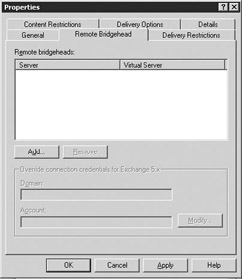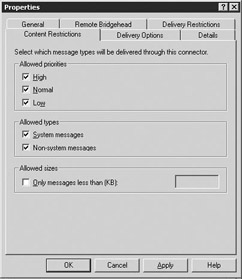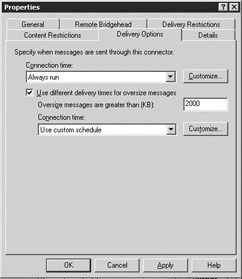6.9 Creating a Routing Group Connector
|
| < Day Day Up > |
|
You can create a Routing Group Connector using the following procedure.
-
Start ESM from the Windows Start menu by selecting All Programs →Microsoft Exchange →System Manager.
-
Expand the Administrative Groups section.
-
Expand the administrative group (e.g., First Administrative Group) that contains the routing group where you want to add a connector.
-
Expand the Routing Groups section.
-
Expand the routing group where you want to add the connector.
-
Right-click on the Connectors section and select New →Routing Group Connector.
-
General tab On the General tab, enter a name for the new Routing Group Connector (Figure 6.22). You should use a descriptive name that helps identify the two routing groups being connected (e.g., Dallas-St. Louis Routing Group Connector).

Figure 6.22: Routing Group Connector General tab -
In the Connects this routing group with drop-down list, select the target routing group.
-
In the Cost field, enter a logical connection cost between 1 and 100. A logical cost value is associated with each connector between two routing groups. The Routing Engine uses information about connectors, costs, and link states to determine the next system to which a message should be transferred. When there are multiple possible routes between two systems, the cost is used to force a preferred path on the basis of the lowest cost of the available connectors.
-
Select These servers can send mail over this connector if you want to have one or more bridgehead servers for your local routing group. Use the Add button to select the local bridgehead servers. With a bridgehead server, all e-mail passes through the bridgehead server, which handles transmission of the message to other routing groups. Multiple bridgehead servers provide a degree of load balancing and redundancy in case one of the bridgehead servers should fail.
-
Select Any local server can send mail over this connector if you do not want a bridgehead server for the local routing group. If you do not specify a bridgehead server, then all Exchange servers in the routing group will share responsibility for transmitting messages to other routing groups.
-
Select the Do not allow public folder referrals check box to prevent public folder referrals through the connector. By default, public folder affinity is transitive, meaning that public folder referrals are available to all other servers in the connected routing group. Selecting this check box will disable this availability.
-
Select the Remote Bridgehead tab (Figure 6.23).

Figure 6.23: Routing Group Connector Remote Bridgehead tab -
Remote Bridgehead tab Use Add to select one or more remote bridgehead servers in the routing group to which you are connecting.
-
If the remote bridgehead server you select is an Exchange 5.x server in a different Exchange 5.5 site, use the Override connection credentials for Exchange 5.x option to supply the credentials necessary to connect to the remote server. ESM displays the service account credentials for the Exchange 5.x server in the Domain and Account fields. Select Modify to change the Exchange 5.x service account password. The new password you enter will be strongly encrypted. Because passwords are weakly encrypted in Exchange 5.x, the strongly encrypted password will not be readable by Exchange 5.x servers. Therefore, you will not be able to modify the password unless the routing group connector is in a pure Exchange 2000 or 2003 Administrative Group. When an Exchange 2003 MTA needs to connect to an Exchange 5.x MTA in a different site, it uses the account specified in these fields. If you do not supply override credentials, the Exchange 2003 MTA uses the service account specified on the Administrative Group, which is only specified if the Administrative Group is in a mixed mode.
-
Delivery Restrictions tab Select the Delivery Restrictions tab (Figure 6.24). You can use the options on this tab to accept or to reject messages from any sender listed in the directory.

Figure 6.24: Routing Group Connector Delivery Restrictions tab -
Under By default, messages from everyone are, select either Accepted or Rejected. By default, messages from all senders are accepted.
-
If you select Accepted, all messages will be accepted, except for messages from senders you specify in the Reject messages from list.
-
If you select Rejected, all messages will be rejected, except for messages from senders you specify in the Accept messages from list.
-
-
If you selected Rejected, use the Add button under Accept messages from to select specific senders from whom mail will be accepted. You can add users, contacts, or groups.
-
If you selected Accepted, use the Add button under Reject messages from to select specific users, contacts, or groups from whom mail will be rejected. If a sender's name is in the Reject messages from list, messages from that sender will be returned to the sender.
-
Content Restrictions tab Select the Content Restrictions tab to specify the priority and types of messages that can be delivered through this connector (Figure 6.25).

Figure 6.25: Routing Group Connector Content Restrictions tab -
Select any combination of the High, Normal, or Low check boxes to specify priorities for outgoing messages that can be delivered through this connector. By default, all priorities can be delivered. If you clear one of the check boxes, no messages with that priority will be delivered through the connector.
-
Select any combination of System messages or Non-system messages to specify the types of outgoing messages that can be delivered through this connector. System messages are messages generated by Exchange or Windows (e.g., directory replication messages, public folder replication messages, delivery reports, NDRs), rather than interpersonal messages from users.
-
Select the Only messages less than (KB) check box and use the associated field to specify a maximum size for outgoing messages delivered through this connector. By default, there is no message size limit.
-
Delivery Options tab Select the Delivery Options tab to specify a connection schedule for the connector (Figure 6.26).

Figure 6.26: Routing Group Connector Delivery Options tab -
Use the Connection time drop-down list to select the time when messages will be delivered through this connector. You can accept one of the intervals on the drop-down list or select Customize to display the Schedule dialog box where you can specify the desired schedule.
-
Select the Use different delivery times for oversize messages check box if you want a different delivery schedule for large messages.
-
In the Oversize messages are greater than (KB) field, enter the message size that you want to be considered 'oversize.'
-
Use the Connection time drop-down list to select the time when oversize messages will be delivered through this connector. You can accept one of the intervals on the drop-down list or select Customize to display the Schedule dialog box where you can specify the desired schedule.
-
-
Details tab Select the Details tab.
-
Use the Administrative note field on the Details tab to enter additional information about the Routing Group Connector. One good use of this field is to record configuration changes.
-
Select OK when finished.
-
The system will display a message asking whether you would like to create the Routing Group Connector in the remote routing group. (Remember that Routing Group Connectors are unidirectional.) If you select Yes, the system will automatically create the remote Routing Group Connector. If you elect to create the Routing Group Connector in the remote routing group, the name of the remote Routing Group Connector will be the same as you specified on the General tab. For example, the 'Dallas to Seattle' connector will be given the same name on the Seattle side of the connection where it would be more logical to call it the 'Seattle to Dallas' connector.
|
| < Day Day Up > |
|
EAN: 2147483647
Pages: 128
- Chapter VI Web Site Quality and Usability in E-Commerce
- Chapter VII Objective and Perceived Complexity and Their Impacts on Internet Communication
- Chapter XI User Satisfaction with Web Portals: An Empirical Study
- Chapter XIII Shopping Agent Web Sites: A Comparative Shopping Environment
- Chapter XVIII Web Systems Design, Litigation, and Online Consumer Behavior